Continuation of the torment of the “old man”: what mines do to the T-54 tank
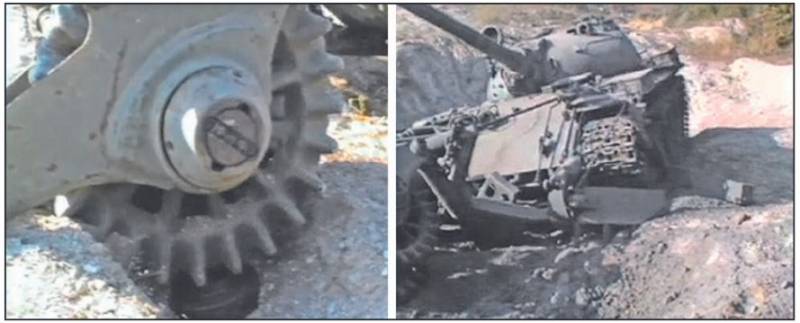
We have previously written about the consequences of firing at the T-54 with missiles from anti-tank missile systems and cumulative shells from various artillery systems. You can read about this here и here. Now it’s the turn of anti-tank and anti-personnel mines, and, as always, the Hungarian report on testing this vehicle from 1989 will help us.
Of course, it presents only a small part of the currently available arsenal of weapons of this type: anti-personnel mines MON-200 and an improved analogue of PMN-1 in the form of GYATA-64, as well as anti-tank UKA-63 (with a shock core) and the high-explosive classic TM-62P3 . But even this modest list gives an understanding of the impact on the tank in any case.
By tradition, the conditions are still the same. From systems tank All flammable liquids were drained, the ammunition was replaced with inert rounds (training), and wooden mock-ups dressed in uniform were installed in the appropriate places as crew simulators.
Anti-personnel mine MON-200
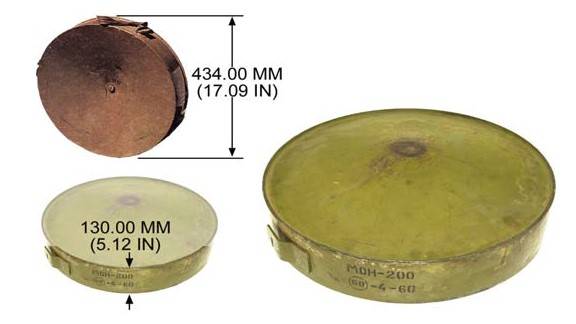
First in line will be the MON-200 directional anti-personnel mine, which is also used against unarmored and lightly armored vehicles. Let us remind you that it contains 12 kilograms of explosives and 900 ready-made submunitions with a lethal flight range of up to 240 meters. During testing, the MON-200 was installed at a distance of 30 meters from the T-54 tank at a height of 150 centimeters from the ground.

Installation of a MON-200 mine thirty meters from a T-54 tank
The detonation of the MON-200 mine and the hail of its destructive elements shattered the tank's optics. External fuel tanks were turned into a sieve, equipment was demolished from the fender. The second road wheel was also severely damaged, which can be seen in the photo attached below. Of course, there was no penetration of the armor: the ready-made striking elements of the mine left dents up to 12-15 millimeters deep. The tank requires minor repairs after such an execution, but taking into account the damage to the optics, its operation in combat conditions would be difficult.
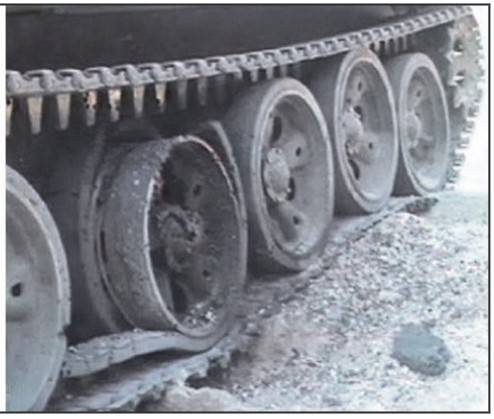
Damage to the T-54 road wheel after an MON-200 mine exploded
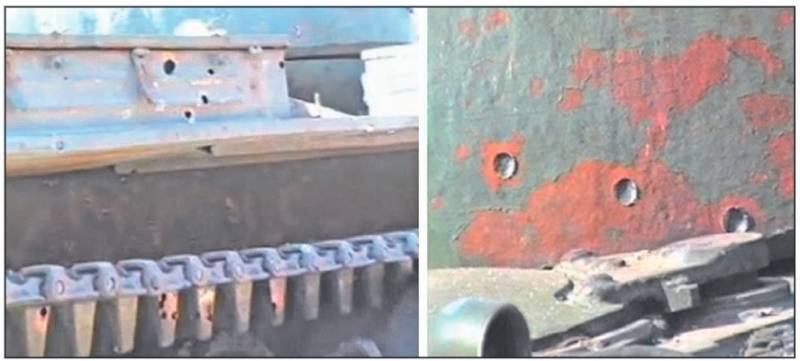
Damage to a tank after a MON-200 mine exploded. It can be seen that the caterpillar was slightly damaged
Anti-personnel mine GYATA-64 (Hungarian analogue of the Soviet PMN-1 with an increased explosive charge)
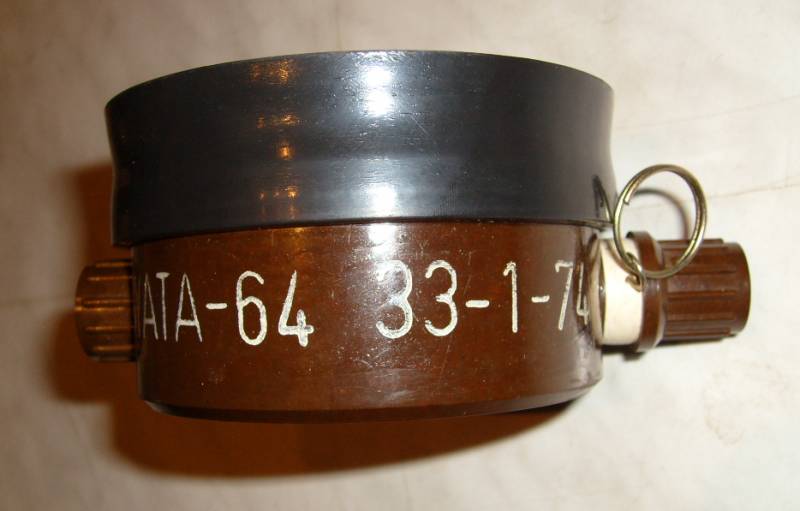
This experiment, of course, looks somewhat strange, since an anti-personnel mine is unlikely to cause any damage to the tank. Still, its destiny is infantry and light armored and unarmored vehicles on wheels. But, as the report says, the commission did not expect stunning results - they simply decided to see what would happen from the explosion of 300 grams of TNT under the T-54 tracks and the KMT-5 rutted mine trawl.
In principle, as was clear from the very beginning, the explosions of GYATA-64 did not bring any significant results. The detonation of a mine under the trawl roller did not cause anything other than a loud bang, as well as chipped and scorched paint on the surface of this KMT-5 element. About the same thing happened during the explosion under the knife section - the explosion simply lifted it slightly and knocked off the paint coating.
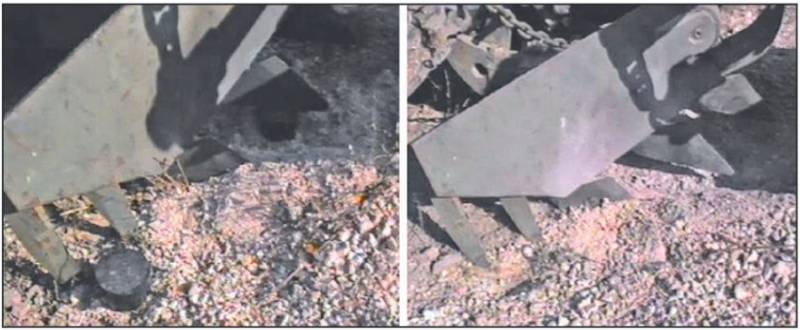
Consequences of a GYATA-64 mine exploding the blade section of a trawl. On the left is a photo before the explosion, on the right is after
A mine detonation near the first road wheel (in the bow of the tank) damaged the track track, bending a pin and tearing the eyes for its fastening. The damage is not serious: the tank has not lost its mobility, and repairs can be carried out quickly enough by the crew. At the same time, the T-54 chassis received even less damage when a mine exploded in the area of the fourth road wheel, except, perhaps, for its broken rubber.
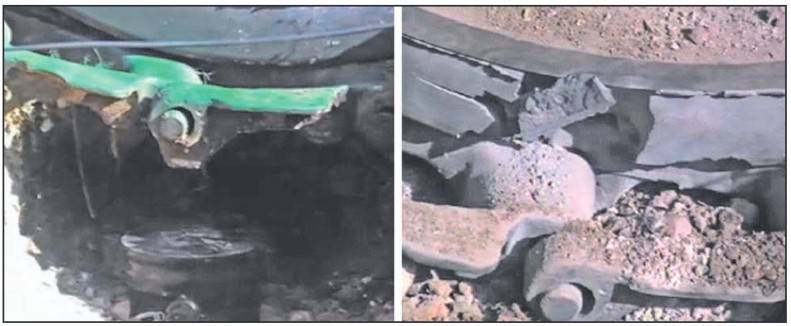
Consequences of the explosion of a GYATA-64 mine under the fourth road wheel. On the left is a photo before the explosion, on the right is after
Hungarian anti-tank mine UKA-63
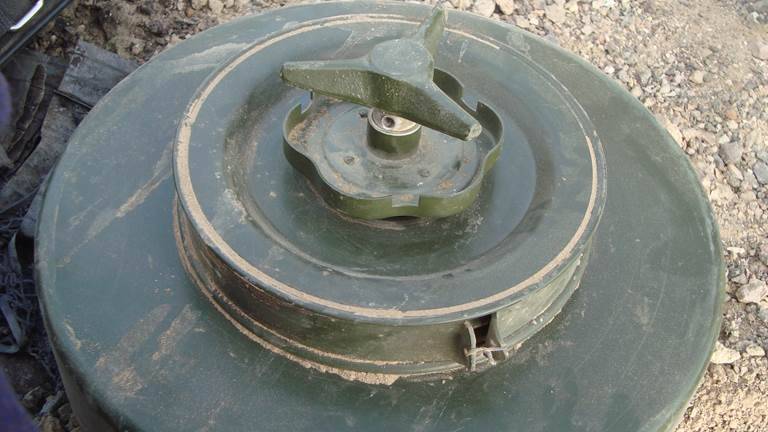
This Hungarian mine is a very serious opponent of a tank and any other armored vehicles due to the large amount of explosive (6 kilograms) and its operation on the principle of an impact core. Therefore, they decided to test it on the T-54 tank even in the most atypical projection.
The detonation of a UKA-63 mine under the left rollers of the KMT-5 threw them up, partially tearing off the left part of the trawl. The force of the explosion damaged the tank's fender, throwing off some equipment. At the same time, the car remained safe and sound, but the trawl required serious repairs. At the same time, the second explosion under the blade section of the trawl completely deformed it, which can no longer be eliminated through repairs.

Placement of UKA-63 mine under the KMT-5 roller on the left and the consequences of the explosion on the right
The third detonation of the UKA-63 mine was carried out under the bottom in the area where the driver was located, and, presumably, the consequences of this for the tank were catastrophic. The cumulative warhead of the mine pierced the bottom and literally turned the driver simulator into splinters. The torsion bars of the road wheels were severely damaged. The fragments pierced the tank rack with fuel and ammunition in it and damaged the batteries. In any case, all this would have ended either in a fire or in the complete destruction of the tank as a result of the detonation of the ammunition. So the T-54 could not be restored, and of the entire crew, with a very low probability, only the loader could survive, but with extremely serious injuries.

Placing a UKA-63 anti-tank mine under the bottom of a tank
The explosion of a UKA-63 mine under the third road wheel did not cause such large-scale damage. However, the third and fourth skating rinks were so damaged that it was time to talk about their complete destruction. The track was also torn and the fuel tanks on the fender were torn out. However, the armor was never penetrated, but the crew would still have received minor injuries, and the bottom deformed by the detonation of the mine, coupled with the damaged chassis, gave the tank a ticket for factory repair.
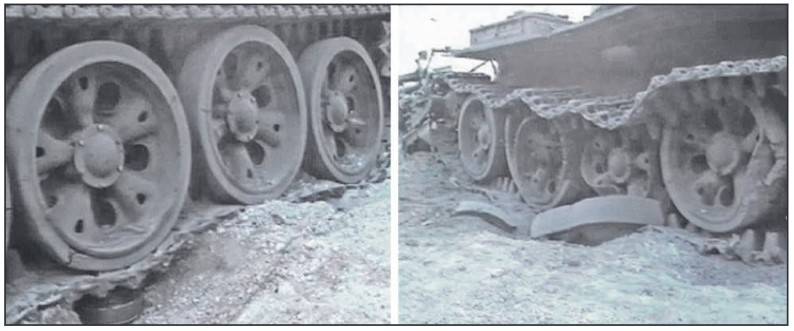
Placement of the UKA-63 anti-tank mine under the track and road wheels in the left photo. The effects of the explosion are depicted on the right.
The detonation of a UKA-63 mine under the bottom of the T-54 in the area of the engine and transmission compartment left a hole approximately 6 by 8 centimeters. The impact core pierced the engine housing, passed through its shaft and stopped in the cylinder block. The crew might have received minor injuries, but the tank requires serious repairs both because of the damaged power plant and because of the deformation of the bottom, which bent 5 centimeters due to the force of the explosion.
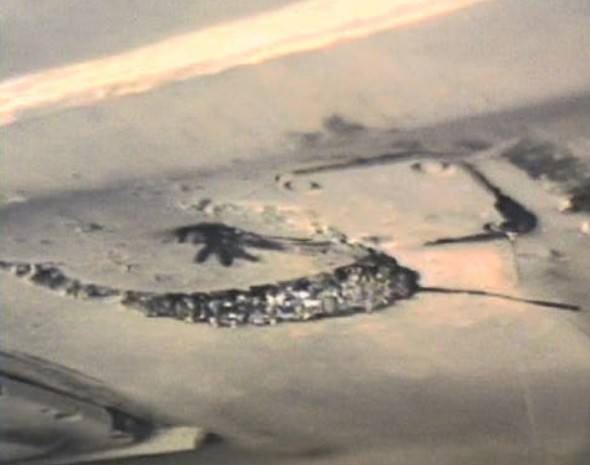
Hole and bottom deformation left by a UKA-63 mine after detonation under the engine and transmission compartment
The detonation of the UKA-63 under the right drive wheel led to its significant damage and rupture of the track. In this case, the crew would not have been injured, but the tank had lost its mobility. Serious repairs are not required, since these faults can be fixed by the tankers themselves.
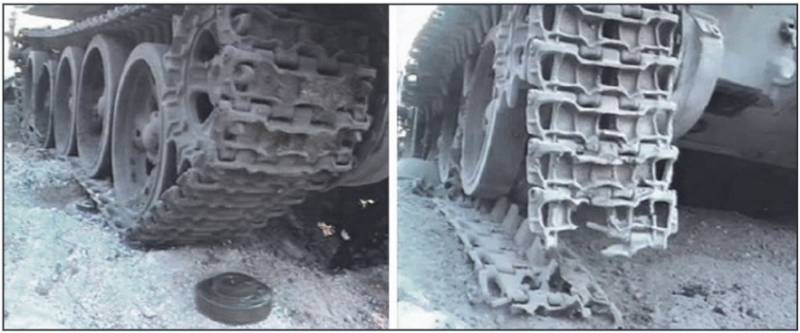
UKA-63 detonation under the left drive wheel of a T-54 tank. On the left is a photo before the explosion, and on the right after it
They decided to carry out the last test with the UKA-63 mine in a non-standard way, installing it on the roof of the T-54 turret. It is doubtful that anyone would use this mine in this way, but the dire consequences are obvious. The mine pierced the armor of the roof and, penetrating into the fighting compartment, damaged the breech of the tank's gun. Of course, there would be no detonation of ammunition and no fire. However, all the tankers in the turret would have been seriously injured or killed, and restoring the tank’s combat capability is only possible in factory conditions.
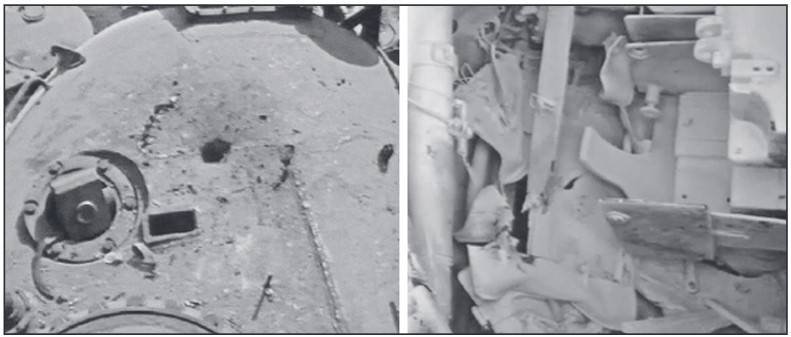
Consequences of a UKA-63 mine exploding on the roof of a T-54 turret
Anti-tank/anti-track mine TM-62P3 (modification with a polyethylene casing)
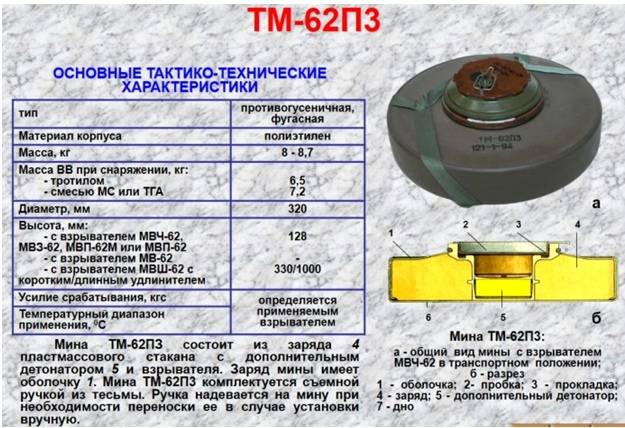
The first detonation of the TM-62P3 mine was carried out on the knife section of a mine trawl, simulating its work of removing explosive devices from the ground and throwing them away from the track. As a result of the explosion, a piece approximately corresponding to the size of the mine was torn off. Neither the tank nor the crew can be harmed in this situation, but the trawl needs repairs.
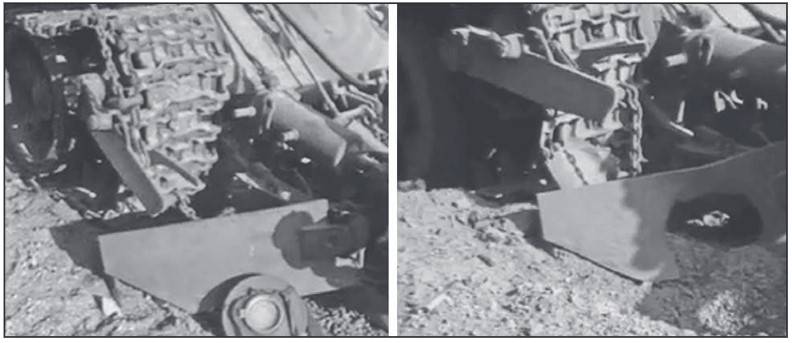
Detonation of a TM-62P3 mine on the blade section of a trawl. Left – before, right – after
The detonation of a TM-62P3 mine under the second road wheel of the T-54 led to the destruction of the chassis: the roller was torn out, the caterpillar was torn and damaged. The tank crew would have suffered serious, even fatal injuries. The tank is immobilized and requires serious repairs, up to the factory level, or may be completely impractical if the bottom is deformed.
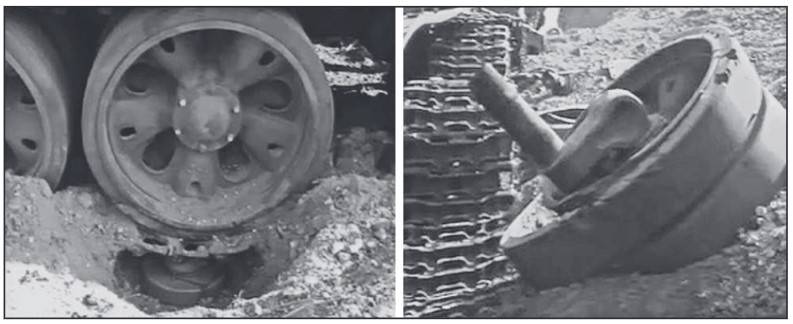
Detonation of a TM-62P3 mine under the second road wheel of the T-54. Left – before, right – after
The detonation of a TM-62P3 mine between the third and fourth road wheels of the T-54 tank led to their significant damage, and the caterpillar was torn in several places. The car is completely immobilized, and the crew would be seriously injured, perhaps even fatally. As in the previous case, the T-54 requires repairs, which are useless if the hull is severely deformed.
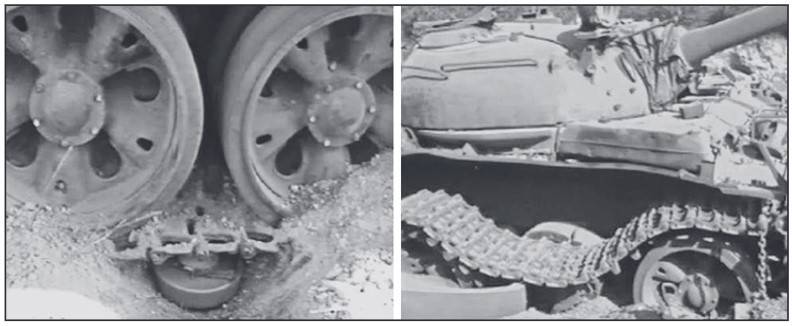
Detonation of a TM-62P3 mine between the third and fourth road wheels of the T-54. Left – before, right – after
The detonation of a TM-62P3 mine under the drive wheel led to minor damage to it and rupture of the track. Neither the crew nor the tank were seriously damaged. The maximum that is required in this case is field repair.
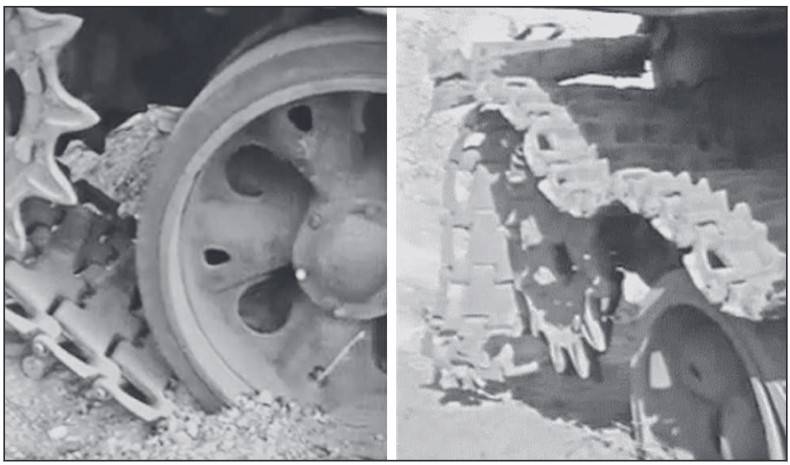
Detonation of a TM-62P3 mine under the drive wheel of a T-54 tank. Left – before, right – after
The TM-62P3 mine was also tested under the bottom of the tank in the area where the driver was located. Its explosion led to the formation of a hole in the bottom. The torsion bars, tank rack with fuel and ammunition were damaged, and the condition of the driver simulator indicated that if there had been a person there, he would hardly have been able to survive. In this case, the tank itself would most likely be destroyed by fire and/or detonation of the ammunition rack. They also detonated a TM-62P3 mine under the bottom in the area of the engine and transmission compartment. Result: a hole in the bottom and total damage to the power plant. And if the crew could have survived, then the tank would have been scrapped in both cases.
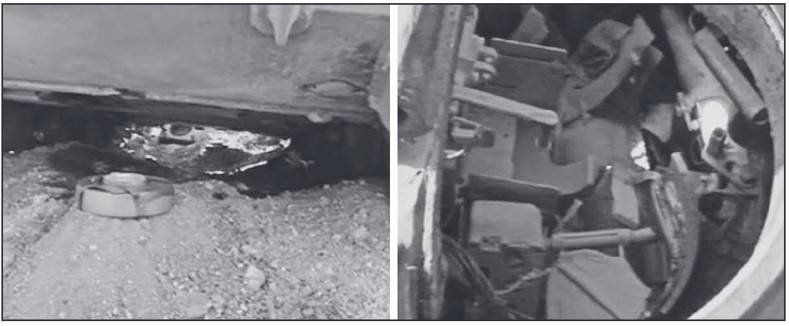
Detonation of a TM-62P3 mine under the bottom of a T-54. Left – before, right – consequences of an explosion inside the tank
As a conclusion, it should be noted that, unlike previous publications that examined the capabilities of the T-54’s armor protection against powerful cumulative projectiles, in this part of the Hungarian report we are more likely talking about what anti-tank and anti-tank weapons can do to a tank without reference to its model. directed anti-personnel mines. Each vehicle's resistance to these munitions is different, but the detonation of several kilograms of explosives under the tracks, the arrival of a shock core at the bottom, or a hail of ready-made submunitions in any case will not do without damage, sometimes very significant.
The source of information:
Kísérleti lövészet T 54-es harckocsikra 1989-ben, a 0 ponti gyakorlótéren IV. rész
Hungarian magazine HADITECHNIKA 2018/6
Information